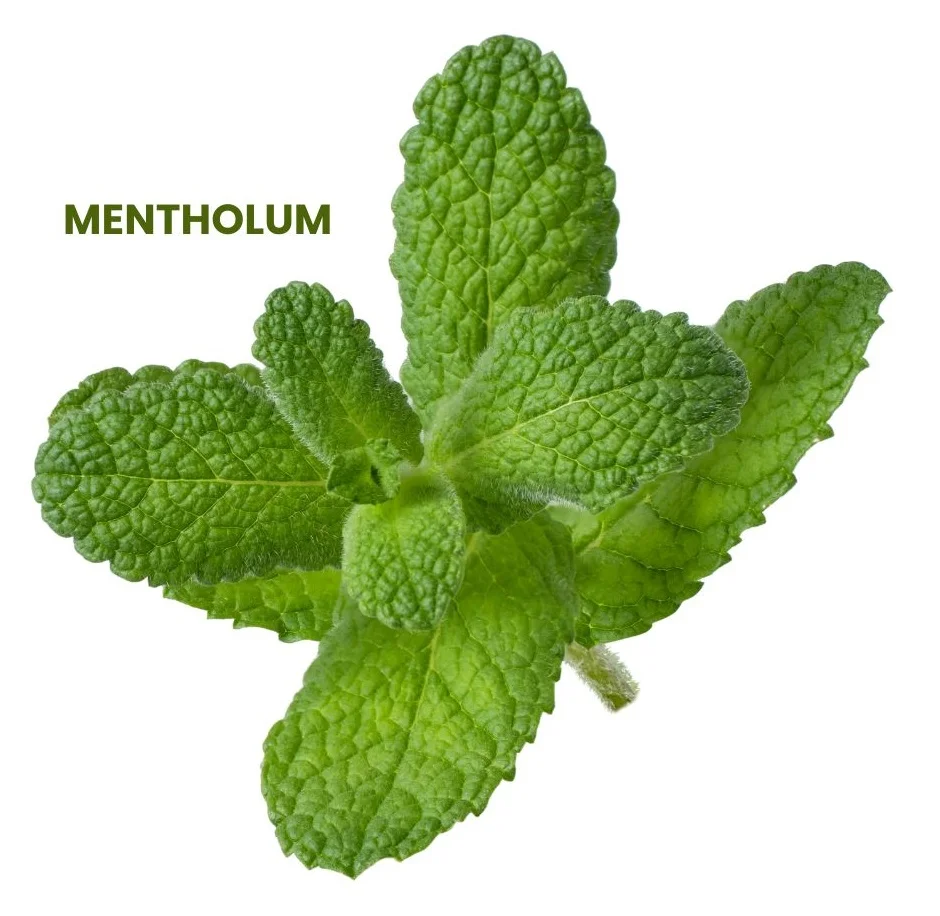Mentholum, commonly known as Menthol, is derived from the essential oil of mint plants, particularly Mentha species.
It has a wide range of therapeutic uses, especially for conditions affecting the mucous membranes of the nasopharynx and for alleviating various neuralgic pains and paresthesias.

Table of Contents
ToggleSOURCE INFORMATION
Scientific Classification
- Kingdom: Plantae
- Clade: Angiosperms
- Clade: Eudicots
- Order: Lamiales
- Family: Lamiaceae
- Genus: Mentha
Origin and Historical Facts
- Natural Source: Menthol is a stearopten (crystalline component) extracted from the essential oil of mint plants, predominantly from species such as Mentha piperita (peppermint) and Mentha arvensis (corn mint).
- Traditional Use: Historically, menthol has been used for its cooling and soothing properties, primarily in traditional medicine for treating colds, headaches, and skin irritations.
- Modern Use: In contemporary medicine, menthol is widely utilized in topical applications for its analgesic and anti-irritant properties, as well as in lozenges and inhalers for respiratory relief.
DRUG PATHOGENESIS
Menthol exerts its effects primarily on the mucous membranes of the nasopharynx and spinal nerve plexus, leading to the alleviation of neuritic pains (nerve pain) and paresthesias (abnormal sensations).
It also has a significant impact on respiratory symptoms and certain types of headaches.
KEY CHARACTERISTICS
HEAD SYMPTOMS
- Frontal Headache: Pain over the frontal sinus that can descend to the eyeballs, often associated with mental confusion.
- Supraorbital Pain: Pain over the left eye, with pain in the face above the zygoma (cheekbone) and numbness.
- Pain in Eyeballs: Associated with coryza (inflammation of the mucous membrane in the nose) and post-nasal dripping.
- Cold Sensation in Nose: A notable cooling feeling inside the nose.
RESPIRATORY SYMPTOMS
- Tickling in the Fauces: Irritation in the throat causing a tickling sensation.
- Stabbing Pains in the Prćcordia: Sharp pains radiating over the chest area.
- Short, Dry Cough: Worsens with smoking and can be associated with asthmatic breathing and congestive headache.
EXTREMITIES SYMPTOMS
- Muscular Pain in Cervical Region: Soreness in the muscles of the neck.
- Lumbar Muscle Soreness: General discomfort and soreness in the lower back muscles.
SKIN SYMPTOMS
- Itching (Pruritus valvae): Intense itching, particularly in the vaginal area, can be relieved with menthol applications.
MODALITIES
- Worse: Symptoms often worsen with smoking and during exposure to cold.
- Better: Relief is generally found with rest and warmth.
WHAT ARE MODALITIES IN HOMOEOPATHY?
RELATIONSHIP WITH OTHER DRUGS
- Compare: Kali bichromicum (Kali bich) and Spigelia (Spigel), which are also used for sinus issues and neuralgic pain.
DOSE
- Potency: Sixth potency is recommended for internal use.
- Topical Use: For external itching, a 1% solution or ointment can be used.
Frequently Asked Questions
What is Mentholum used for?
- Mentholum is primarily used for treating conditions affecting the nasopharynx, neuralgic pains, respiratory issues, and certain types of headaches.
- It also has topical applications for itching.
How does Mentholum help with headaches?
- It alleviates frontal headaches, especially those associated with sinus pain and pressure, mental confusion, and pain that extends to the eyeballs.
Can Mentholum be used for respiratory issues?
- Yes, it helps relieve symptoms such as tickling in the throat, dry cough, asthmatic breathing, and stabbing chest pains.
Is Mentholum effective for muscle pain?
- It is beneficial for muscular pain in the cervical (neck) and lumbar (lower back) regions, providing relief from soreness and discomfort.
How should Mentholum be applied for itching?
- A 1% solution or ointment can be used topically to alleviate itching, particularly in cases of pruritus.
Meaning of Difficult Words
- Stearopten: The crystalline component of an essential oil.
- Naso-pharynx: The upper part of the throat behind the nose.
- Neuritic Pains: Pains that occur along the course of a nerve.
- Paresthesias: Abnormal sensations such as tingling, pricking, or numbness.
- Coryza: Inflammation of the mucous membrane in the nose, causing a runny nose.
- Precordia: The region in front of the heart.
- Pruritus valve: Intense itching of the vulva.
- Eustachian Catarrh: Inflammation of the Eustachian tube, which connects the throat to the middle ear.
Mentholum offers a versatile and effective approach to managing a range of symptoms, from respiratory issues and headaches to muscular pain and itching, making it a valuable addition to the homeopathic pharmacopeia.
